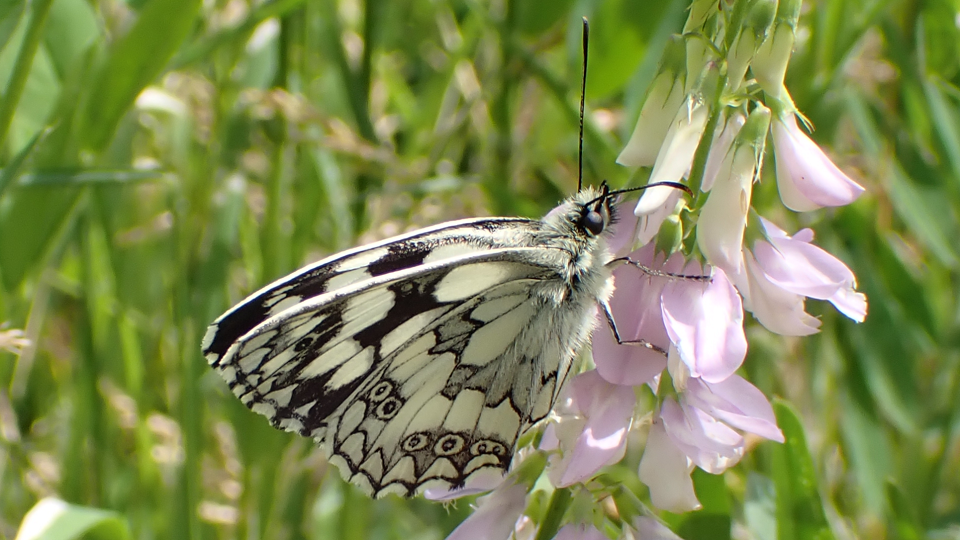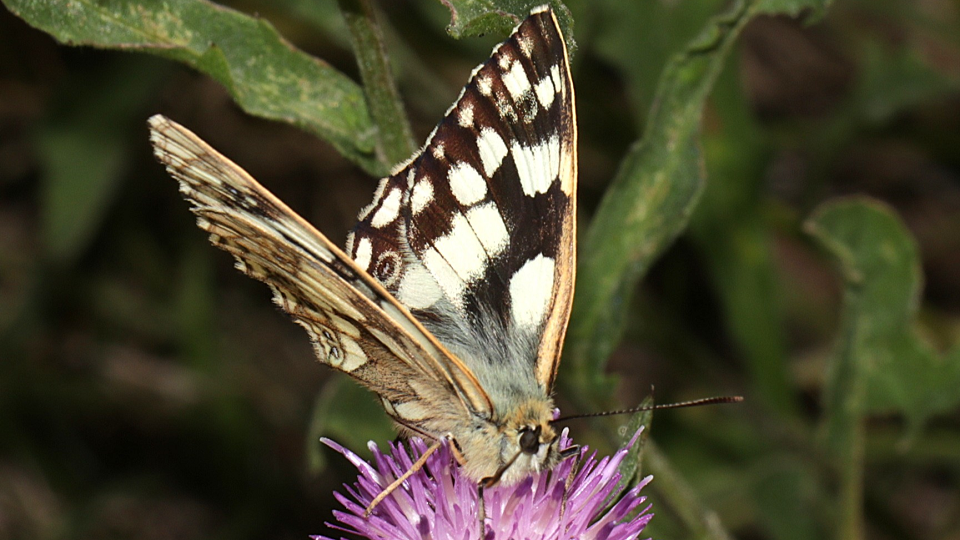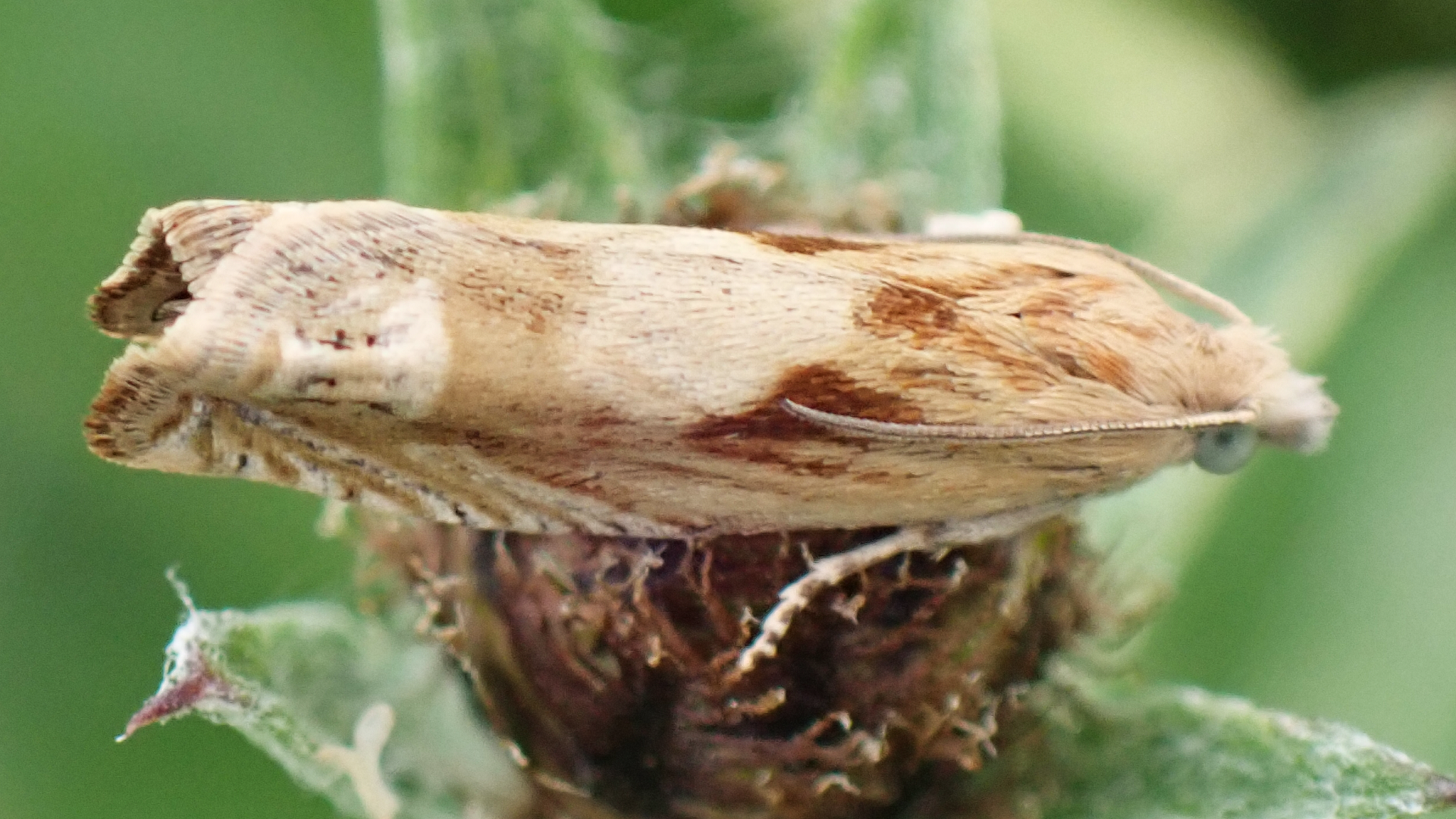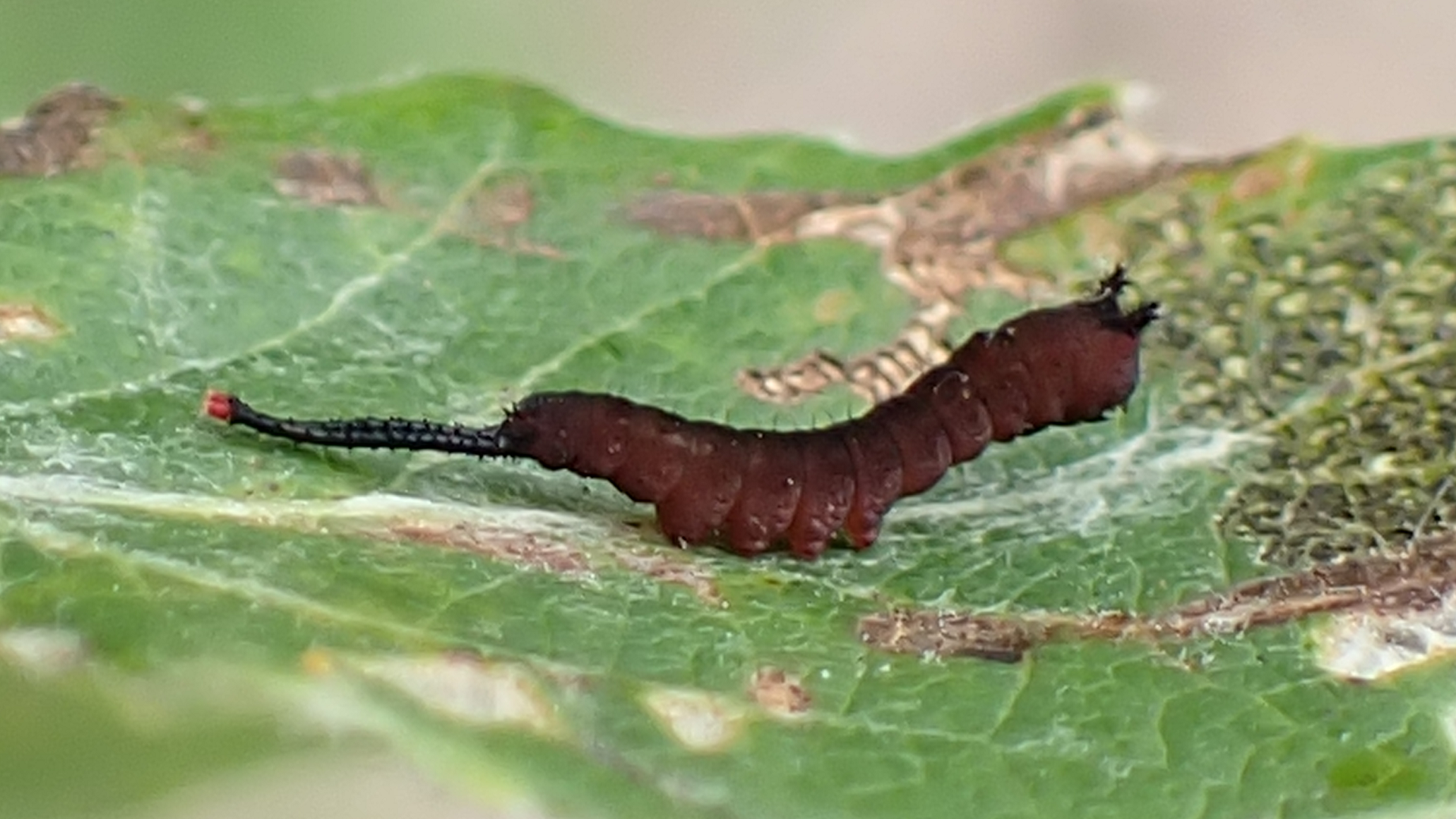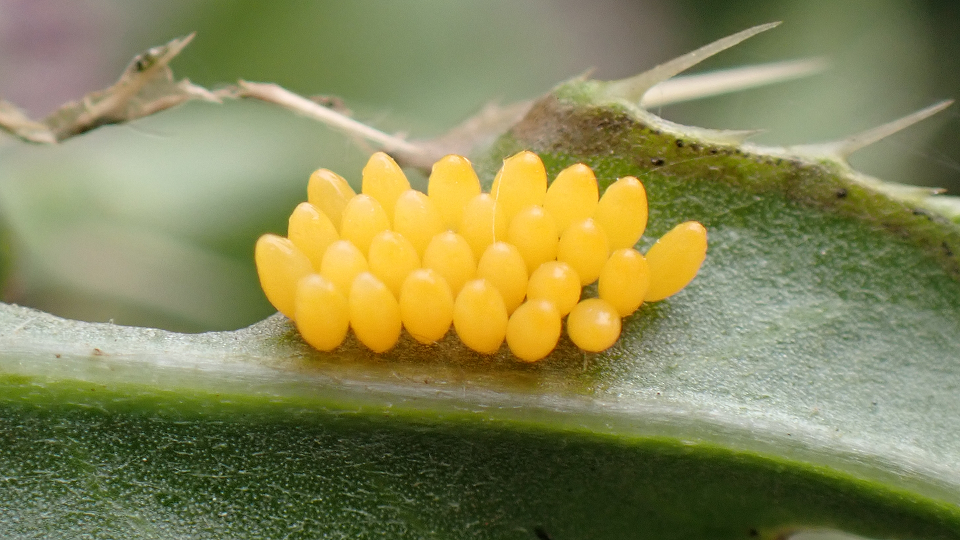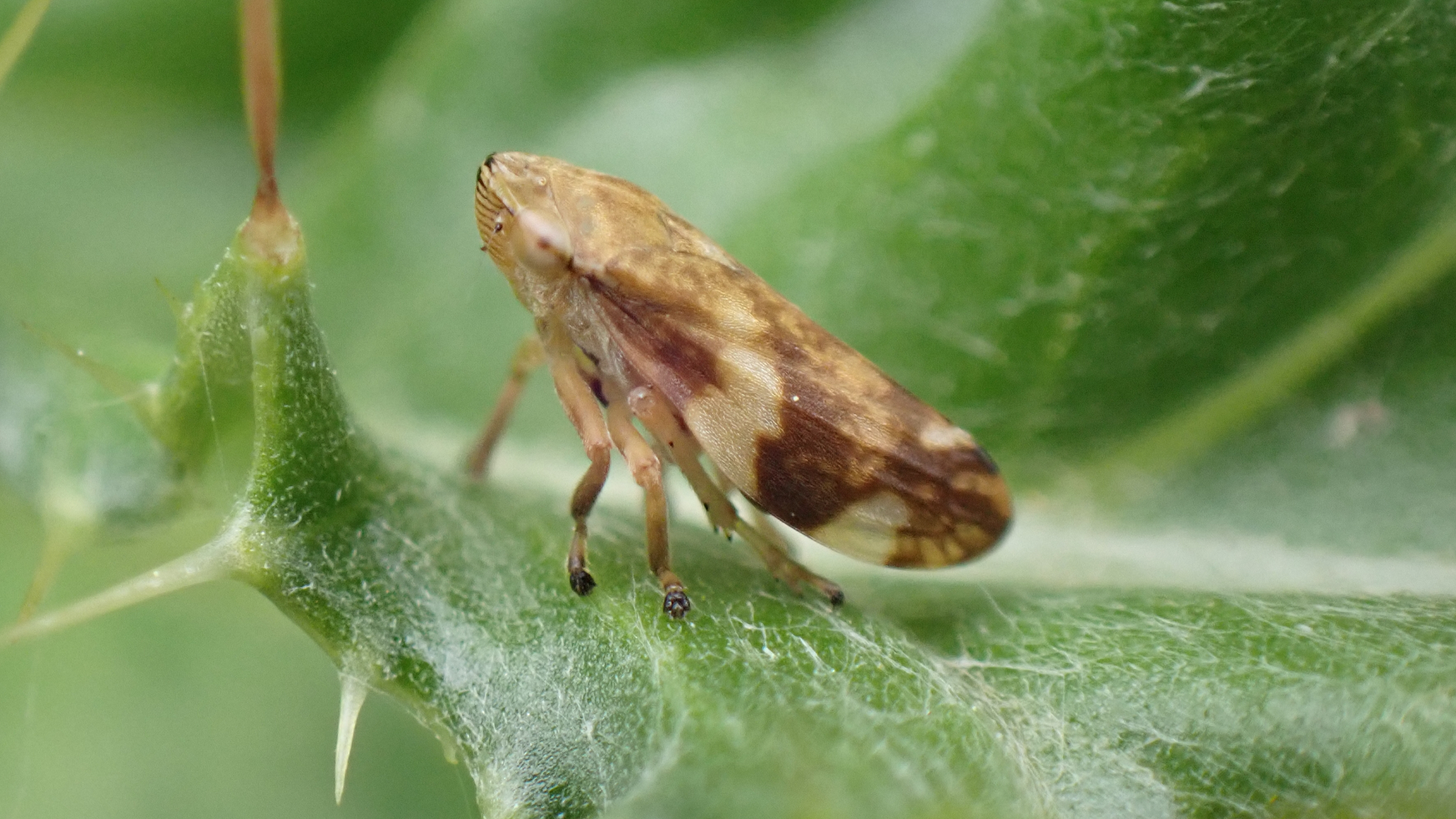JUNE 2025
Comma
Polygonia c-album
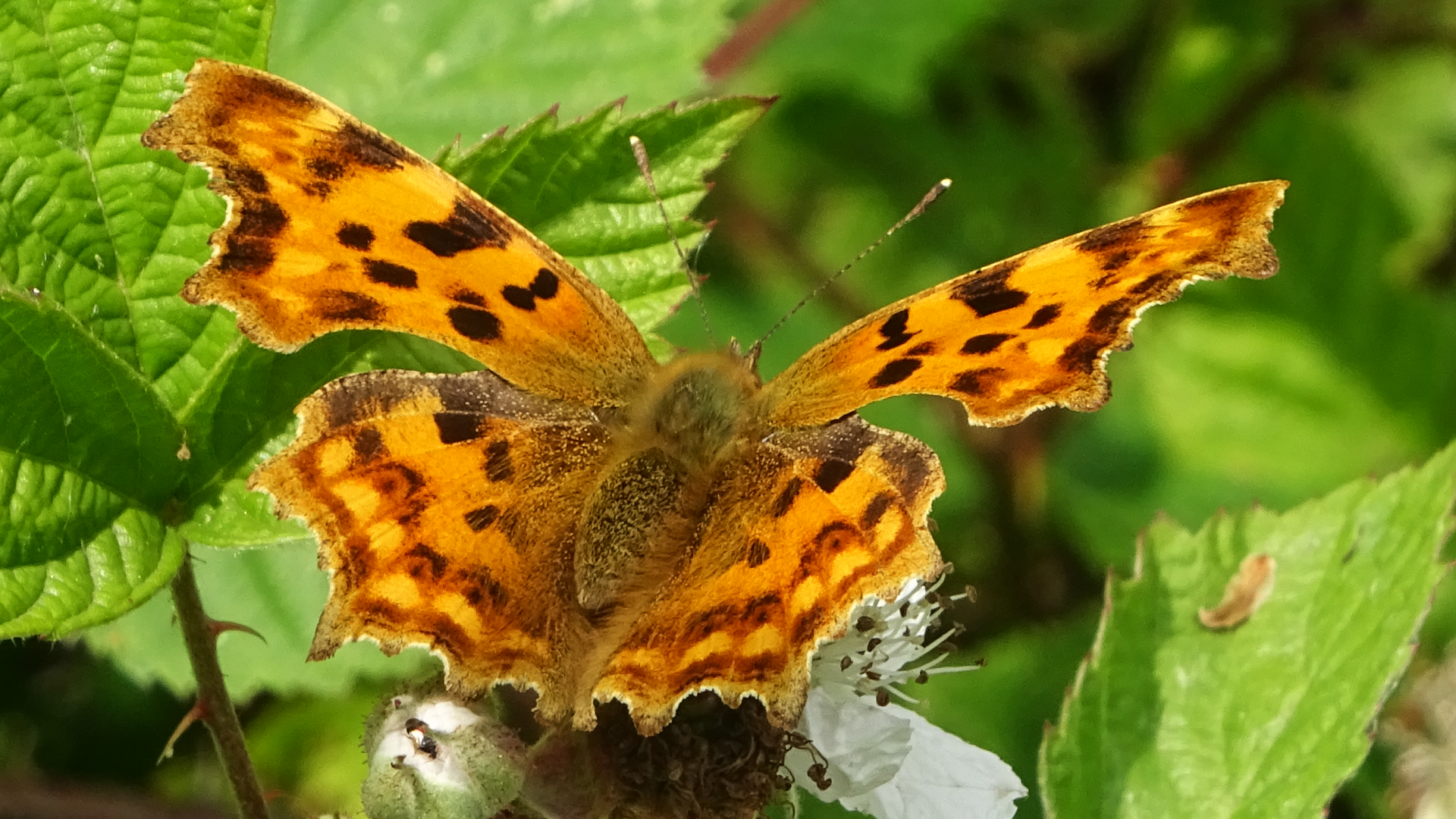
TQ4792 09/06/2025 ©Raymond Small
The Comma has jagged orange-brown upper wings with black and yellowish-brown markings. At rest the Comma resembles a withered leaf. Comma butterflies seek sanctuary on hedgerows located in sunny positions. Their name is derived from a little 'comma' mark on the underside of the wings. Its caterpillars feed on plants such as Common Nettle and Hop.
Marbled White
Melanargia galathea
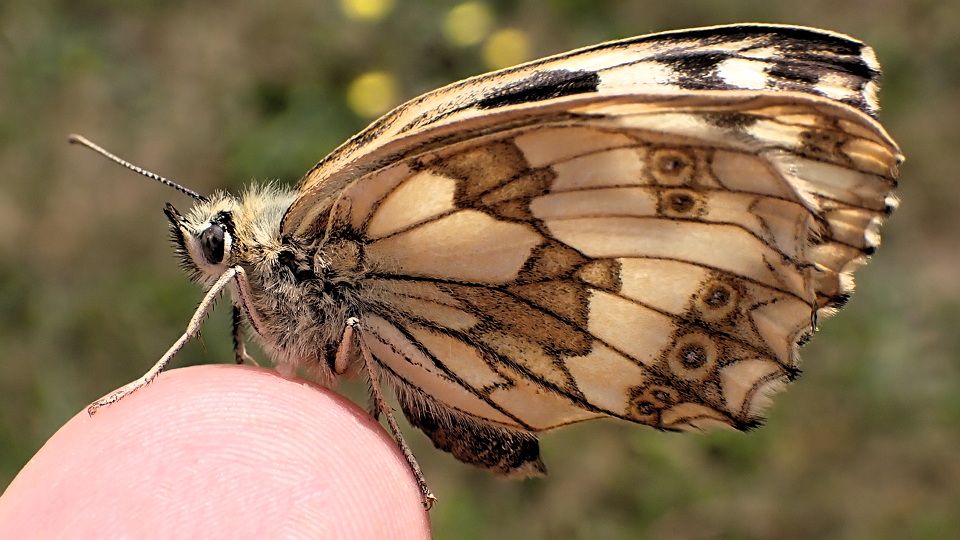
TQ4792 23/06/2025 ©Raymond Small
Since the wildflower meadow has been allowed to flourish near Foxburrow Road entrance this beautiful species is now becoming a regular sight where once it was an infrequent visitor.
Blood-vein
Timandra comae
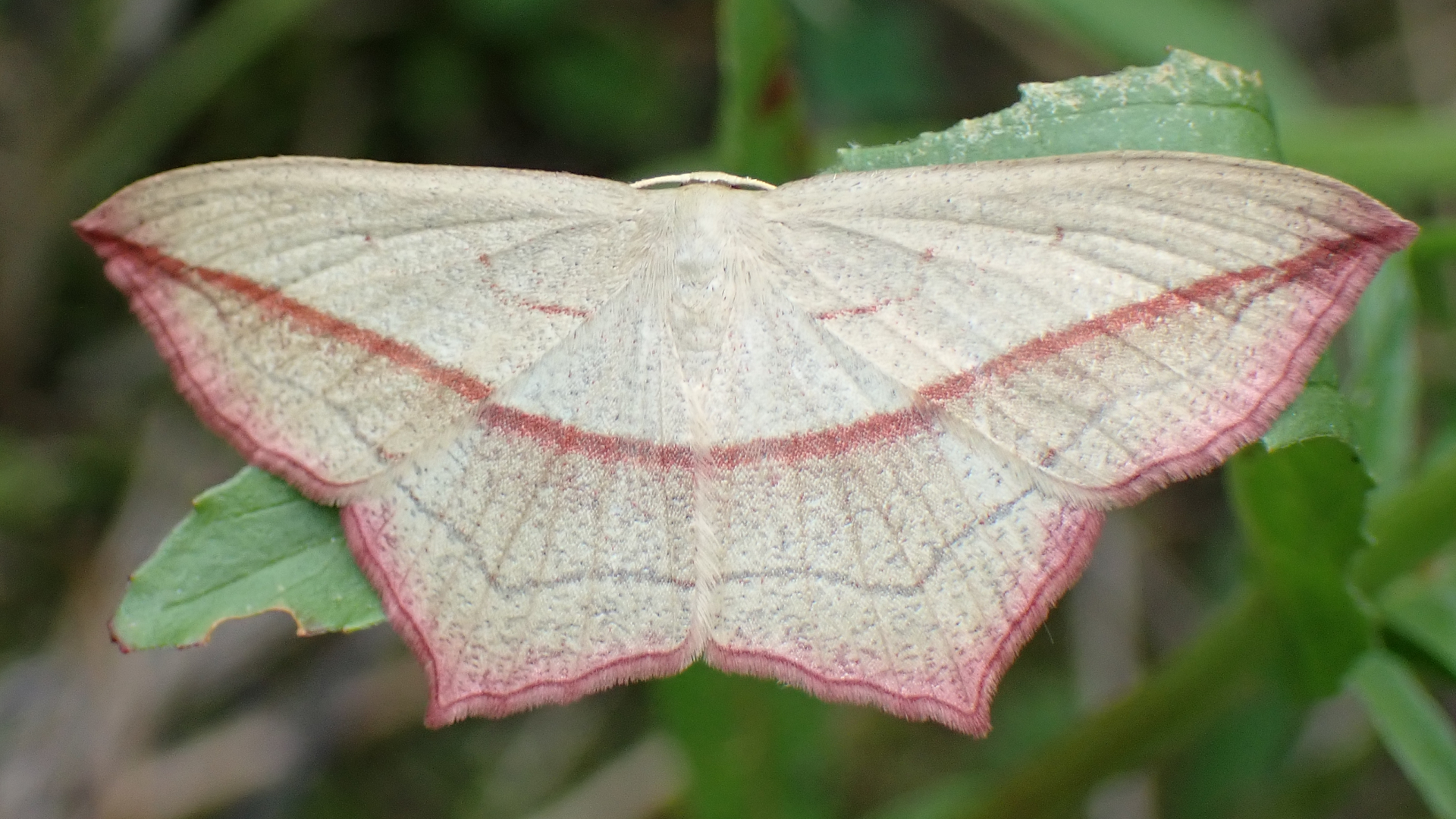
TQ4792 13/05/2025 ©Raymond Small
The Blood-vein is a common moth found in a range of habitats. Its foodplants include: Docks, Common Orache and Common Sorrel.
Orange Beauty
Commophila aeneana
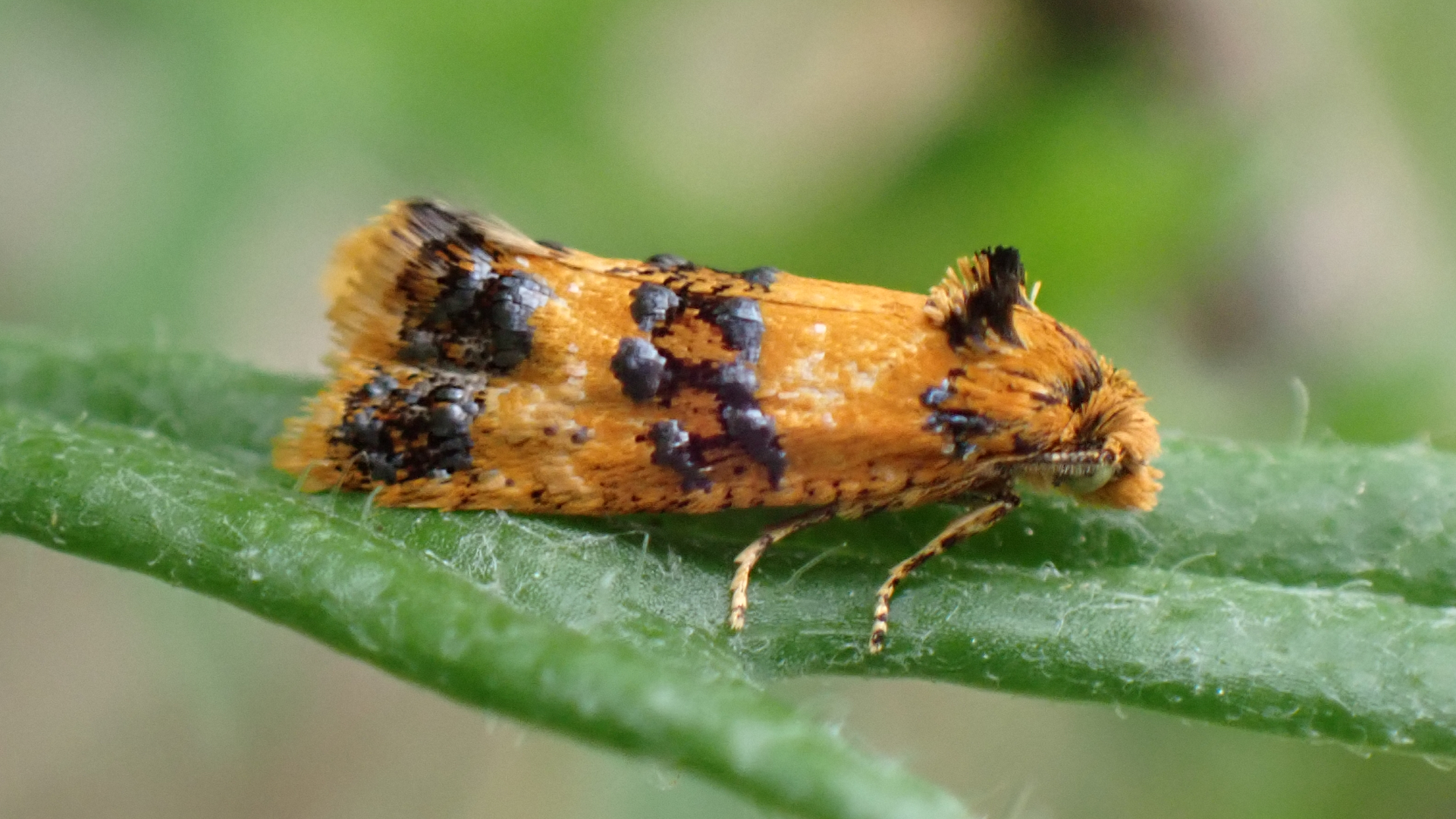
TQ4792 28/05/2025 ©Raymond Small
Adults are on the wing from May until July. Its larvae feed on roots of ragwort.
Poplar Hawk-moth
Laothoe populi
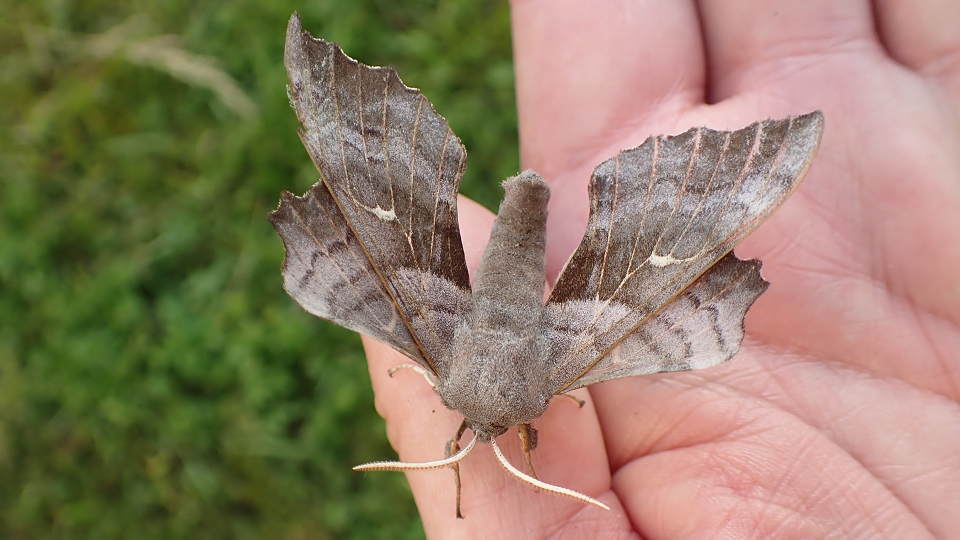
TQ4692 12/06/2025 ©Raymond Small
The Poplar Hawk-moth is a large moth that flies from May to July with a wingspan between 6 and 9cm. They rest with the abdomen curved up and hindwings further forward than the forewings. If disturbed they flash reddish-brown patches on the underwings. The adults do not feed. Their larvae consume poplar, aspen, sallow and willow.
Coronet
Craniophora ligustri
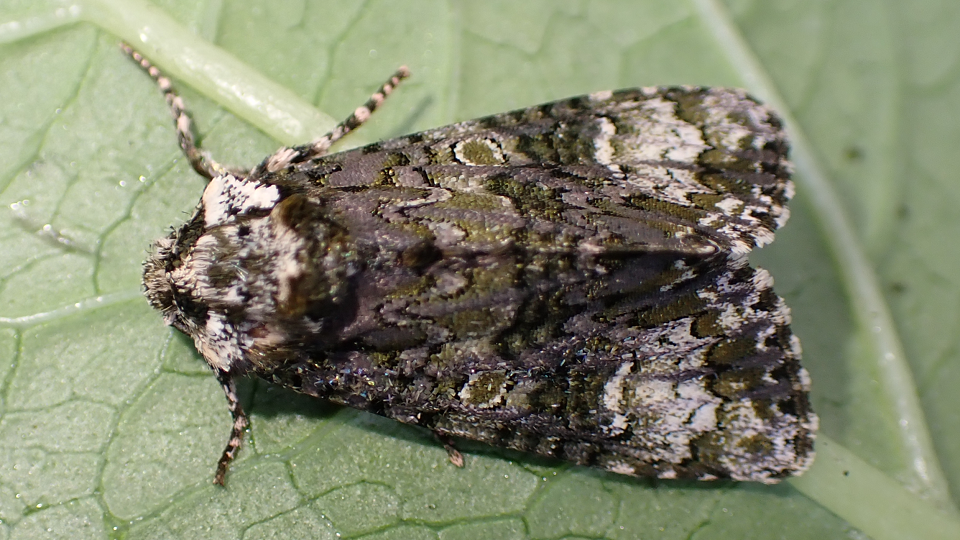
TQ4692 12/06/2025 ©Raymond Small
The Coronet flies from May until August. The forewing colour varies from intense yellowish-green and purple to black and white. Its foodplants are ash and wild privet.
Six-spot Burnet
Zygaena filipendulae

TQ4792 04/06/2025 ©Raymond Small
The yellow caterpillars of the Six-spot Burnet feed on Common Bird’s-foot Trefoil and occasionally on Greater Bird’s-foot Trefoil.
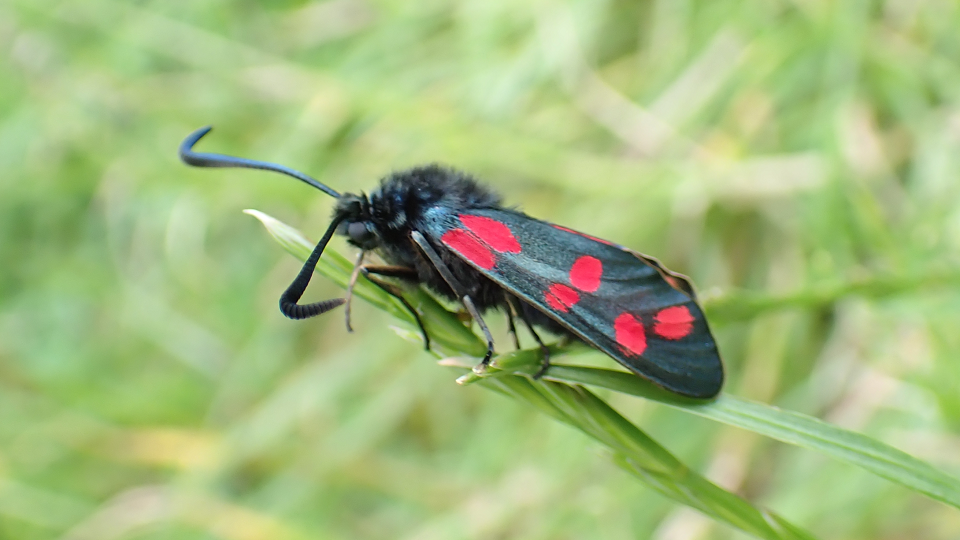
TQ4792 11/06/2025 ©Raymond Small
In June the adults emerge and can be found visiting thistles, knapweeds and scabious, sometimes in large numbers. There are several species of Burnet moth in Britain; this is the only one with six red spots on each forewing. The spots are sometimes fused together.
WARNING: STAY AWAY FROM THESE.
Movie ©Raymond Small / Sign ©Michael Trump
Oak Processionary moths were accidently introduced to England in 2005. They are now established in Greater London and are able to defoliate whole oak trees. Their larvae can cause rashes, eye irritation and breathing problems. They should not be touched. The larvae are usually seen from late May until July and adults fly from July until September.
Vernal Shieldbug
Peribalus strictus

TQ4792 09/06/2025 ©Raymond Small
This greenish-brown shieldbug (9.5-11mm) is covered in dark punctures. The antennae are distinctively banded with the final two segments mostly black. There is a pale tip to the scutellum, a banded connexivum and a rather concave edge to the pronotum behind the eyes. Rarely recorded with most historic sightings likely to be migrants. This is the first known record for Hainault Forest.
Woundwort Shieldbug
Eysarcoris venustissimus
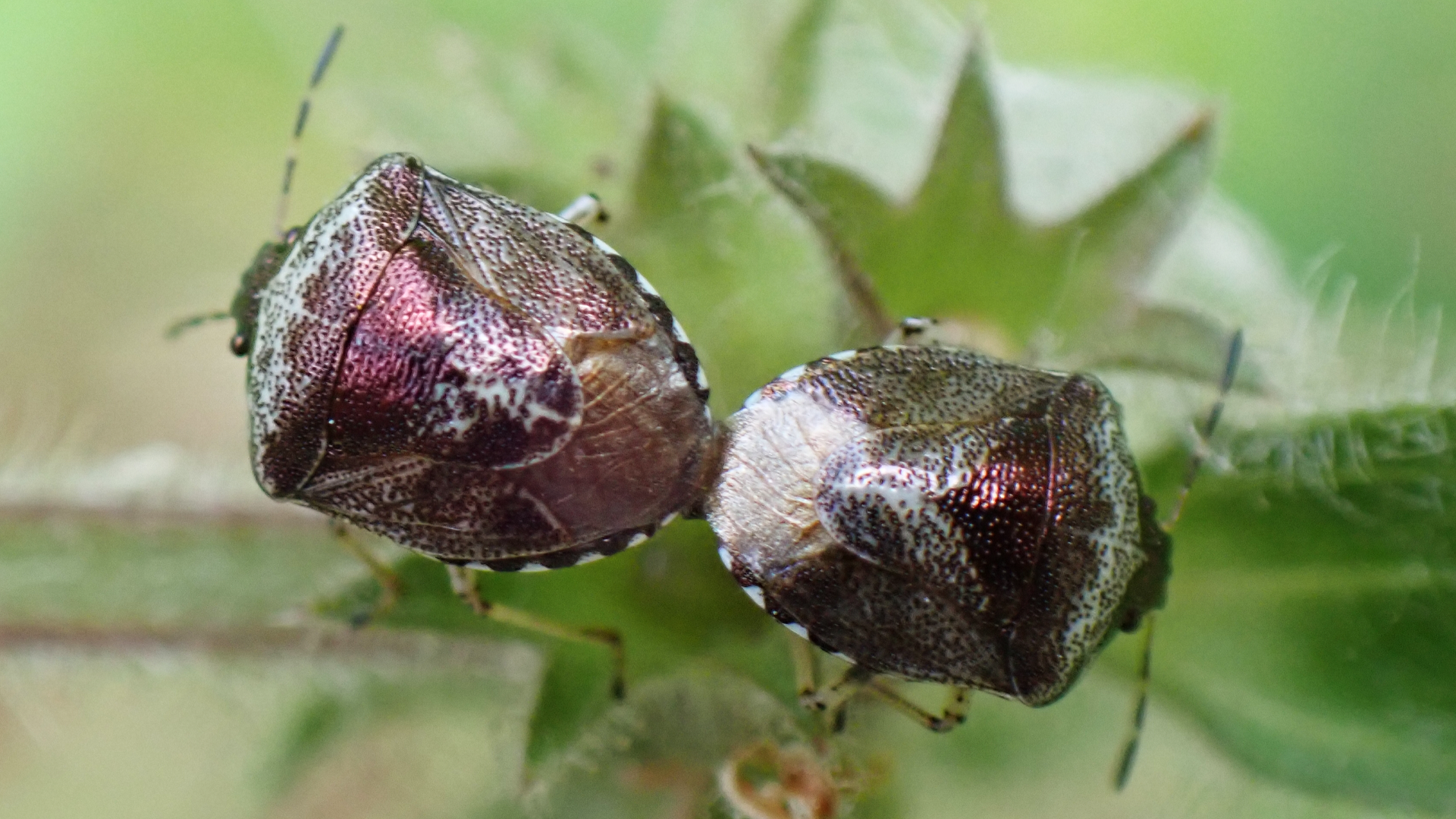
TQ4792 06/06/2025 ©Raymond Small
The small greyish-bronze shieldbug (5-7mm) feeds mainly on hedge woundwort and occasionally on other plants in the same family. The head and the front of both the pronotum and scutellum are copper coloured, while the connexivum is marked with black and white. During the 19th century this species was considered rare but is now becoming more widespread.
Parent Bug
Elasmucha grisea

TQ4792 03/06/2025 ©Raymond Small
The Parent Bug is a loving shieldbug that cares and protects its eggs and young. Females have glands that discharge a foul smelling secretion to deter predators. The larvae disband at the end of the third instar at which point the female leaves as they are able to fend for themselves.
Green Shieldbug
Palomena prasina
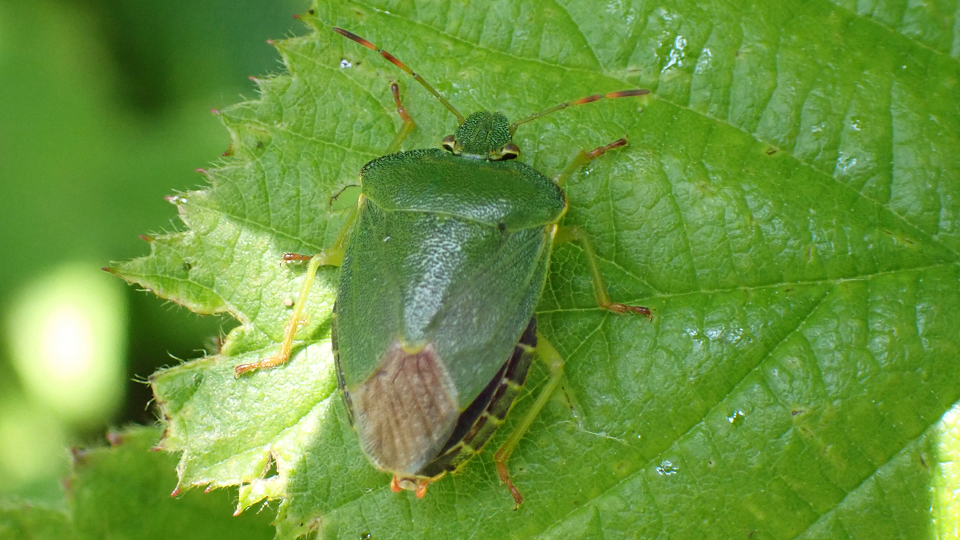
TQ4792 12/06/2025 ©Raymond Small
Green Shieldbugs feed on a wide range of plants. Adults overwinter and emerge in spring to mate. Females lay their eggs on the undersides of leaves.
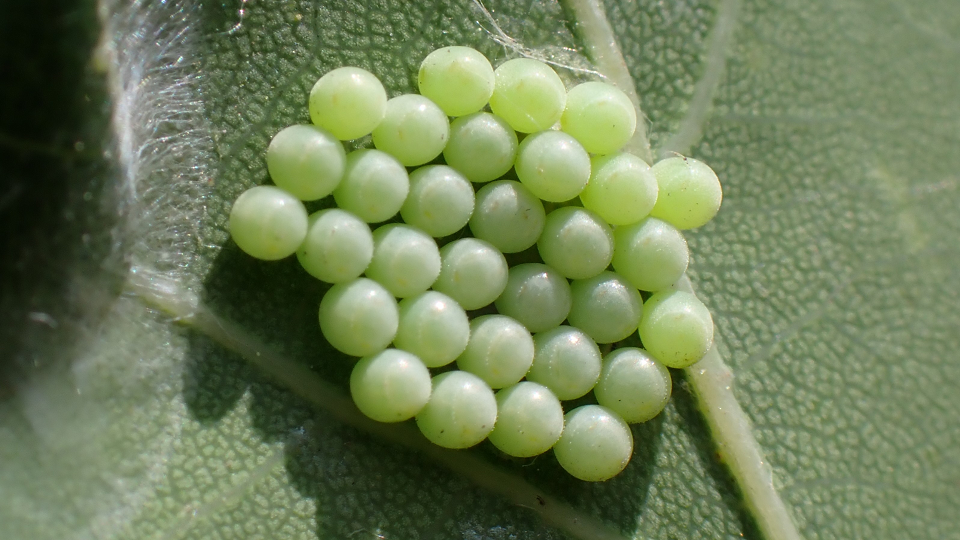
TQ4792 05/06/2025 ©Raymond Small
Unlike the Parent Bug many other types of shieldbug lay and abandon their eggs. The eggs of the Green Shieldbug blend in with the colour of the vegetation so are fairly well camouflaged.

TQ4792 05/06/2025 ©Raymond Small
Green Shieldbug instars are light-green when hatching out. They darken and within an hour or two there is a pattern on the back.
Hairy Shieldbug
Dolycoris baccarum
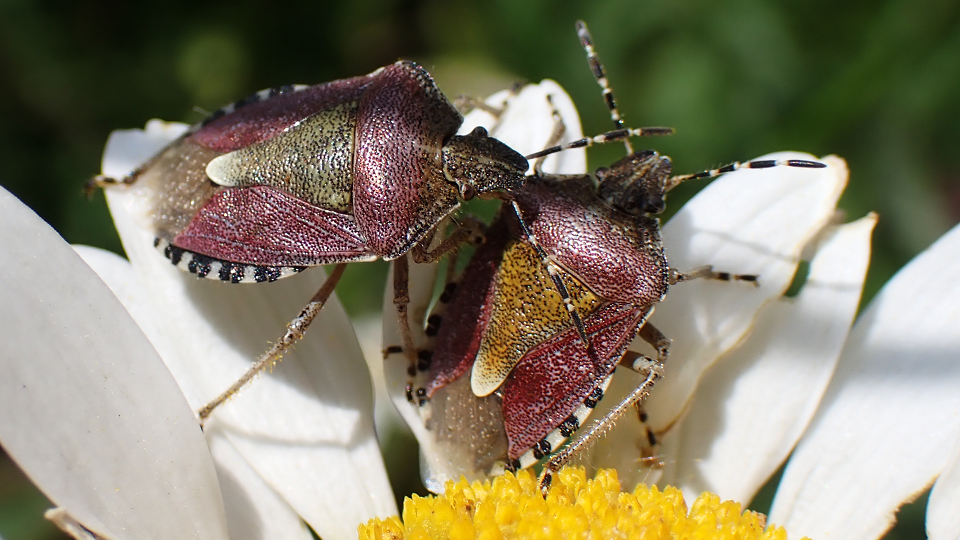
TQ4792 12/06/2025 ©Raymond Small
The Hairy Shieldbug is covered in long hairs. It is found throughout the year along woodland rides and on hedgerows. This species overwinters as an adult and emerges during spring to mate. Larval foodplants include Blackthorn and other members of the Roasaceae family. This species is also known as the Sloe Bug.

TQ4792 11/06/2025 ©Raymond Small
These are early nymphs of the Hairy Shieldbug. When a shieldbug nymph emerges from the egg the top pops open like the lid on a tin of beans.
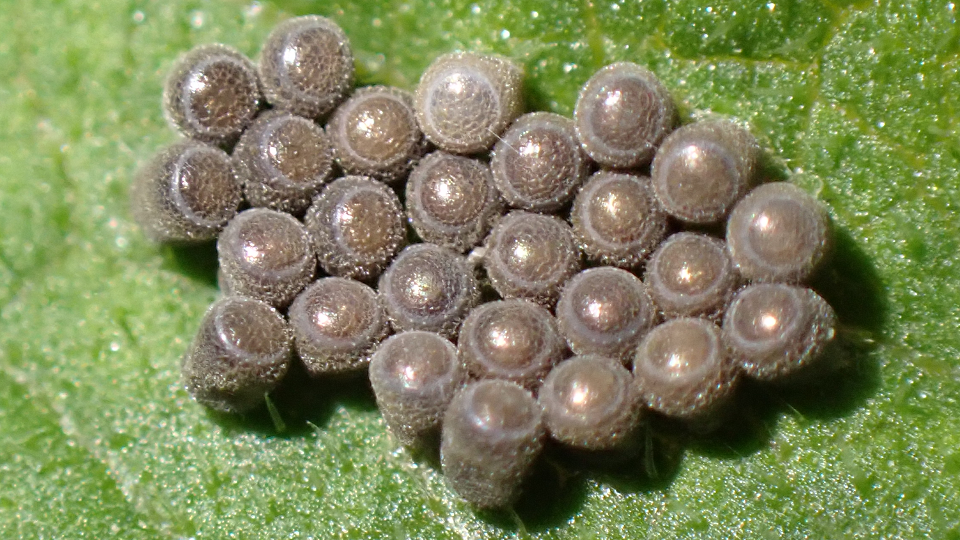
TQ4792 14/06/2025 ©Raymond Small
Not all eggs hatch successfully. These eggs may look normal but a tiny wasp has laid an egg in each egg. Young wasps will emerge instead of shieldbugs.
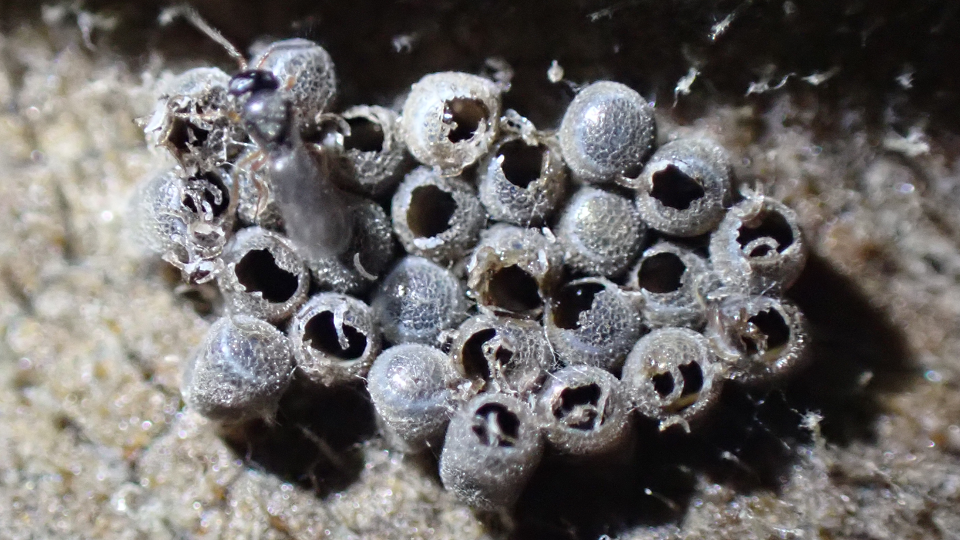
TQ4792 20/06/2025 ©Raymond Small
When a new adult wasp emerges from a parasitized egg it has to chew its way out instead of popping open the top. Thank you to Essex Field Club recorder, Yvonne Couch, for this interesting insight.
Band-winged Stilt-leg
Rainieria calceata
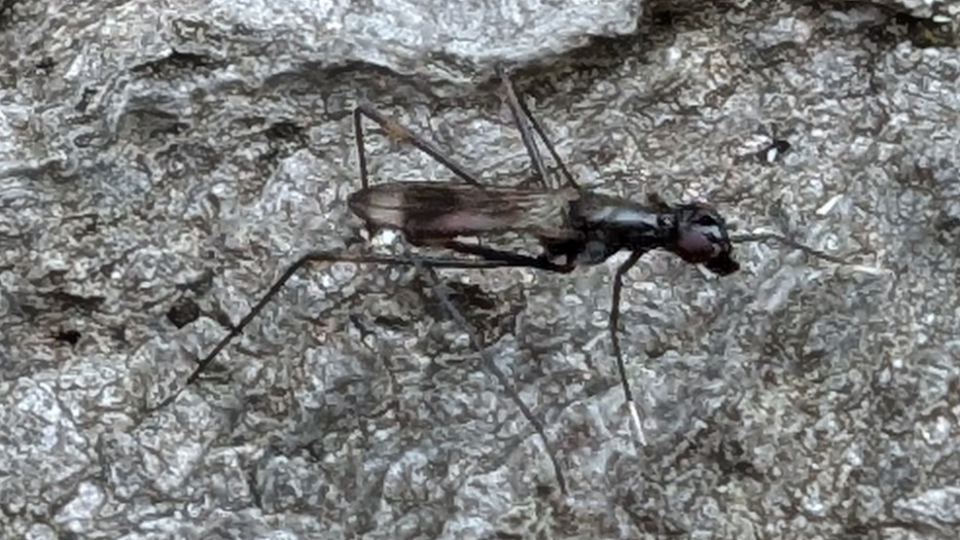
TQ4792 11/05/2025 ©Rob Smith
Rob Smith discovered a dozen Band-winged Stilt-leg flies
at Epping Forest and took this picture. In the afternoon he visited Dog Kennel Hill in Hainault Forest and pointed out one resting on a beech log. Because this is such a scarce species, Darwyn Sumner, who runs the national recording scheme was contacted for confirmation. The main colony is in Windsor Great Park and this species is having difficulty establishing other colonies because it is short of old growth beeches with the necessary fungi and rot holes. Rob's record is probably the first in Essex - what a great find!
Broad Centurion
Chloromyia formosa
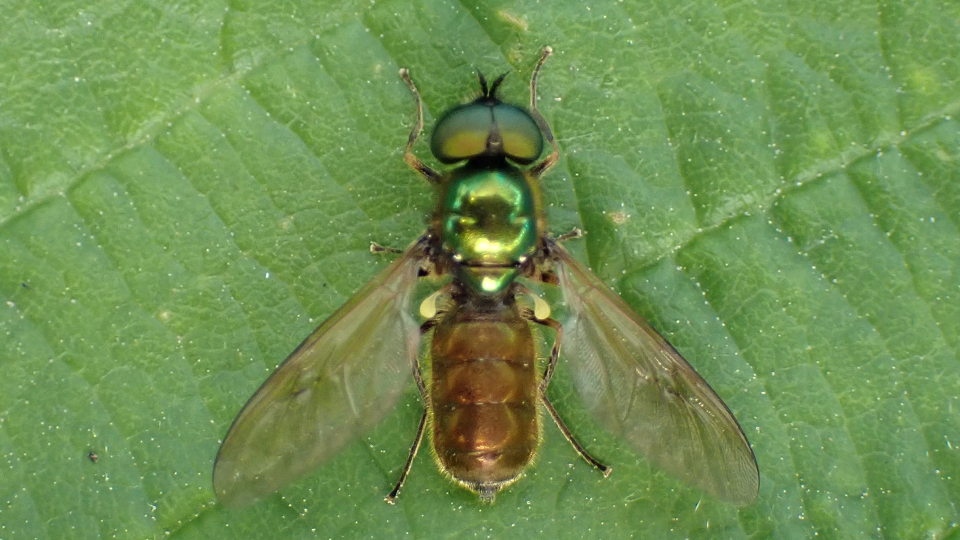
TQ4792 09/06/2025 ©Raymond Small
The Broad Centurion is a soldier fly. The male has a bronze abdomen whereas with the female it is blue-green. There are similar species, but this one can be distinguished by the eyes being covered in thick black hairs. The flight season is from May until August, when it can be found nectaring on flowers in scrub, on hedgerows and in woods. Its larvae feed on decaying organic matter.
Fruit Fly
Urophora sp.
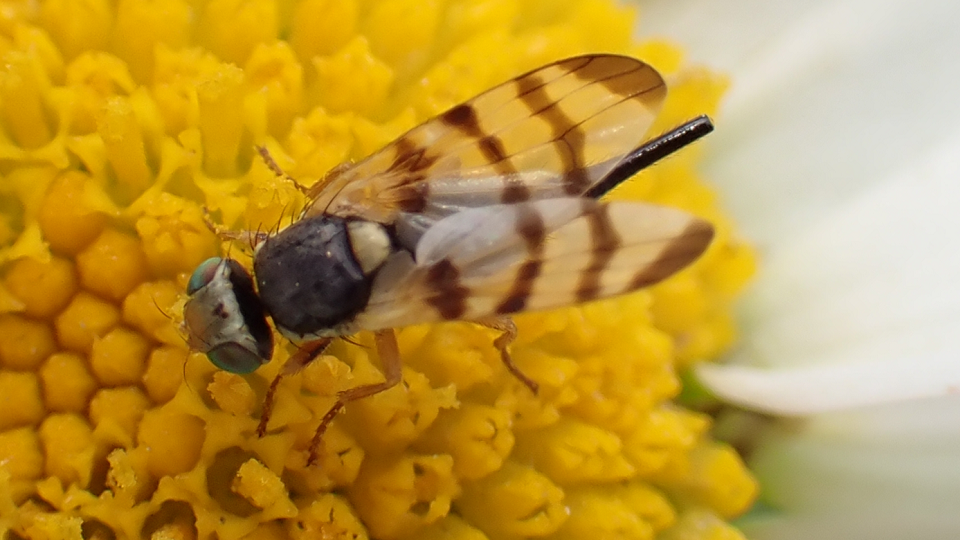
TQ4792 12/06/2025 ©Raymond Small
This well-marked fruit fly is a member of the family Tephritidae. This is possibly
Urophora jaceana, but because several species are similar it has only been recorded to genus. It is one of several flies that cause galls on knapweed.
Wasp Nest
Vespula sp.

TQ4792 23/06/2025 ©Raymond Small
Social wasps sometimes make underground nests. They excavate soil to create cavities where nests are built. Nests are often placed on lawns, under bushes, or in sheltered locations. Wasp nests normally last around 3-4 months. As autumn approaches temperatures fall and the nest dies off with the new queens going into hibernation.
Leafhopper
Alebra albostriella
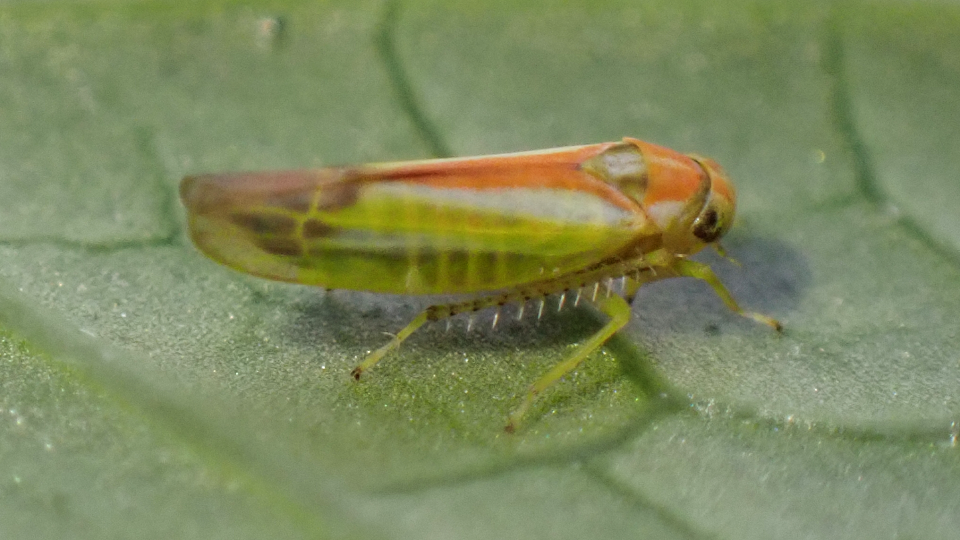
TQ4692 22/06/2025 ©Raymond Small
Measuring 4mm long, this pretty Leafhopper was attracted to a UV light. The colouration and dark spots at the base of the tibial spines identify this as a male of the species. There are distinct differences between leafhoppers and froghoppers. Leafhoppers are normally more slender and smaller, while froghoppers are typically larger and stouter. Froghoppers produce cuckoo spit on plants, leafhoppers do not. Froghoppers have only a few stout spines on their legs, leafhoppers have rows of spines.
Edwardsiana Leafhopper
Edwardsiana
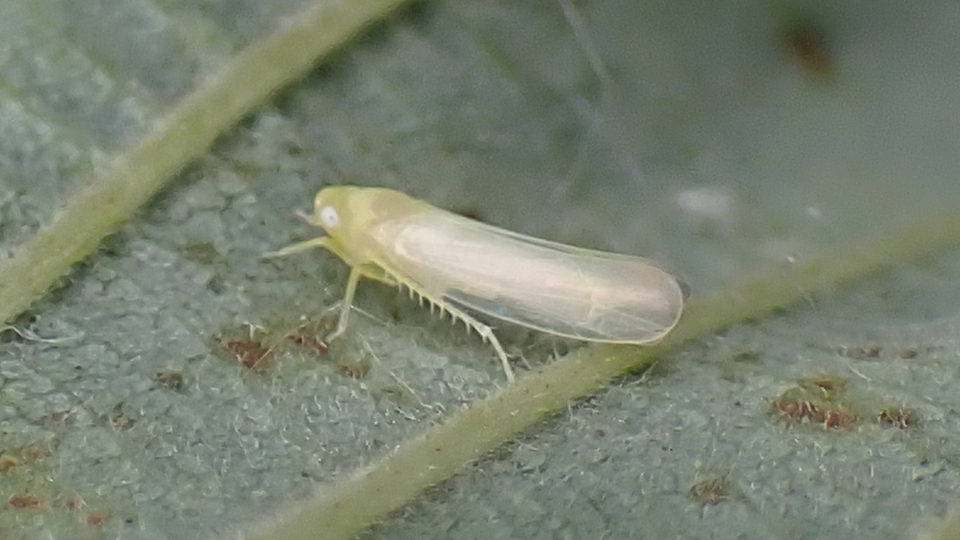
TQ4792 04/06/2025 ©Raymond Small
This tiny Leafhopper found near Hainault Lake was 3-4mm in length. Being on an alder leaf it is possibly Edwardsiana alnicola, but without being examined under a microscope there is no way to be certain of the exact species.
Soldier Beetle
Malthodes sp.
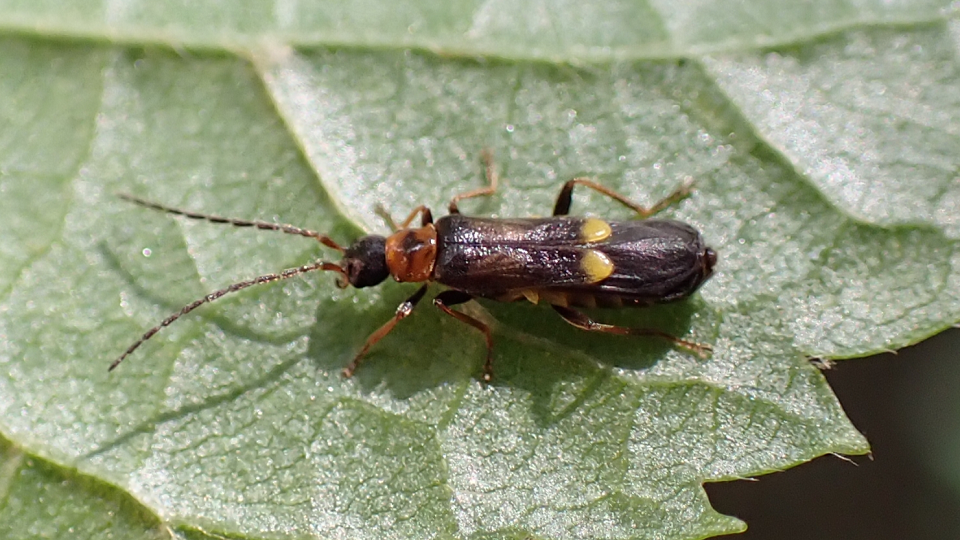
TQ4792 22/06/2025 ©Raymond Small
This tiny Soldier beetle (3-4mm) belongs to a genus with fifteen similar-looking species which usually have dark yellow-tipped wing cases. They live in woodland and in long grass where they prey on other insects. Possibly
Malthodes minimus.
Green Weevil
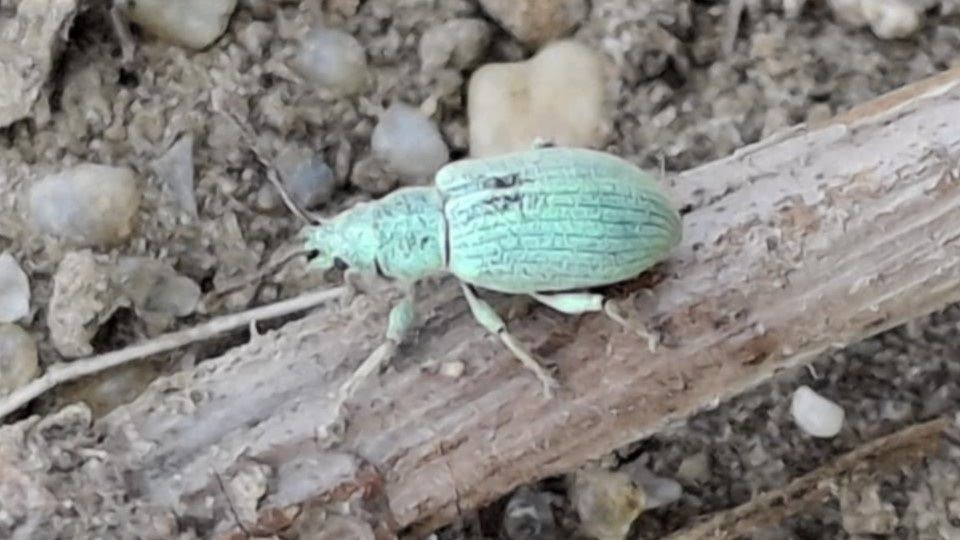
Green weevils are beetles. Their colouration is due to tiny, hair-like scales which usually wear off revealing a dark body underneath. The larvae and adults can be pests of plants, but otherwise are harmless to humans. Many are found on low vegetation and in trees during spring and summer.
©Raymond Brown
Toad Migration Movie
TQ4792 05/06/2025 ©Raymond Small
Early summer young toads emerge from the lake following the tadpole stage. They are often seen on paths - sometimes in huge numbers! Amphibian & Reptile Conservation are always pleased to receive amphibian and reptile records at
Record Pool.
Crow Lane

TQ4792 21/06/2025 ©Raymond Small
Jackdaws and Crows lining one of the freshly cut paths through the wildflower meadow.
Bee Orchid
Ophrys apifera
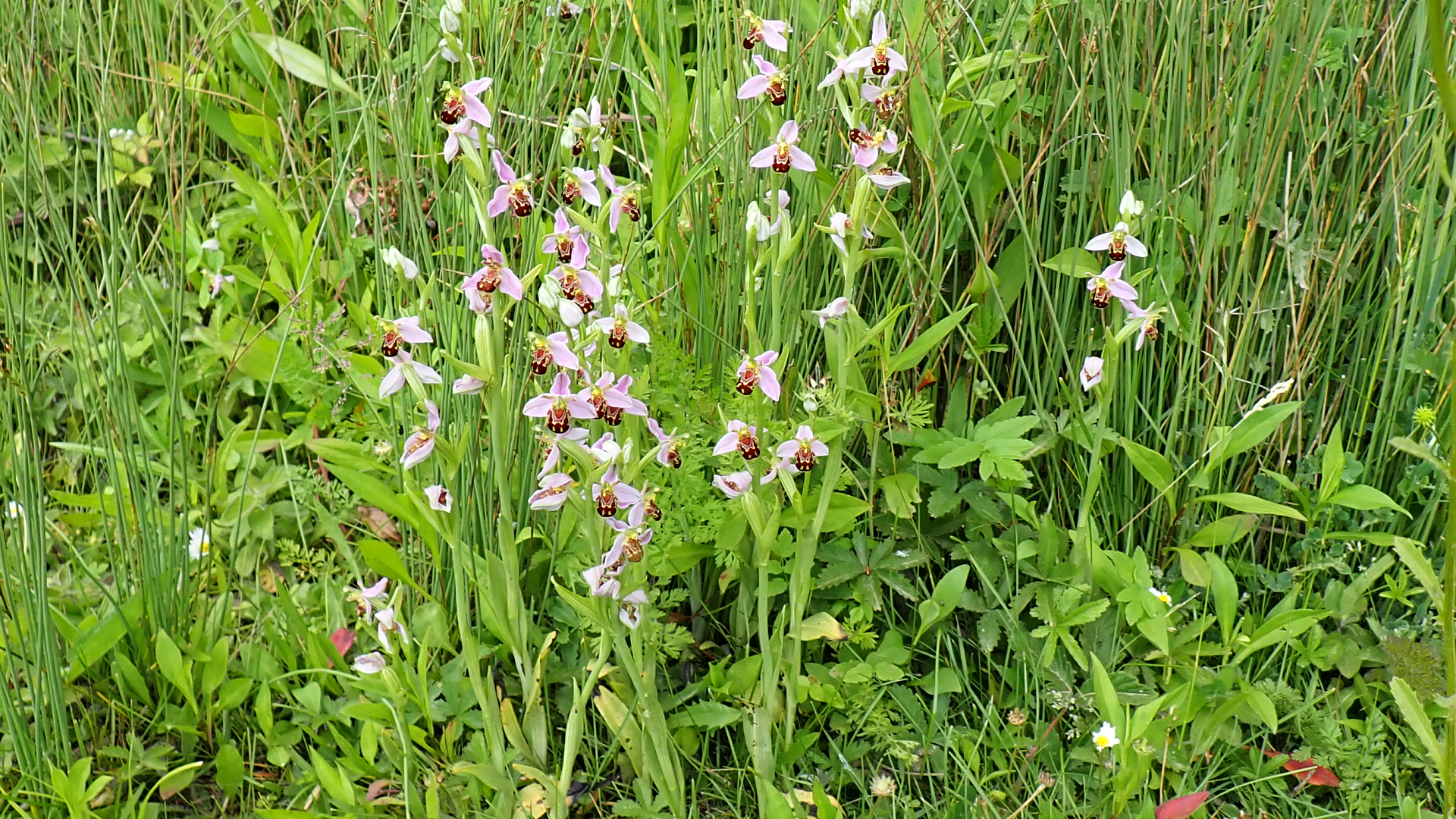
TQ4792 06/06/2025 ©Raymond Small
It has been a good year for Bee Orchids with over three times as many spikes appearing near Hainault Lake than twelve months ago. A total of 134 spikes were counted.
Betony
Betonica officinalis
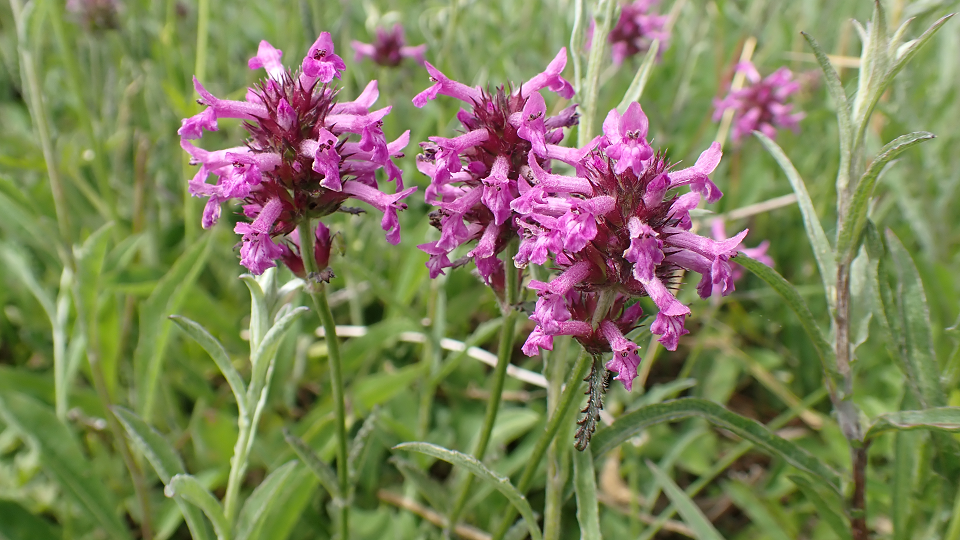
TQ4792 21/06/2025 ©Raymond Small
Betony has a preference for sunny or semi-sunny places on well-drained soils, growing well on heavy clay. Previously seen on Hog Hill, but hasn't been recorded there for 2-3 years. It came as a nice surprise to find two large patches in the wildflower meadow this month. The pretty purple flowers grow on square stems. It is a member of the mint family.
Lady's Bedstraw
Galium verum
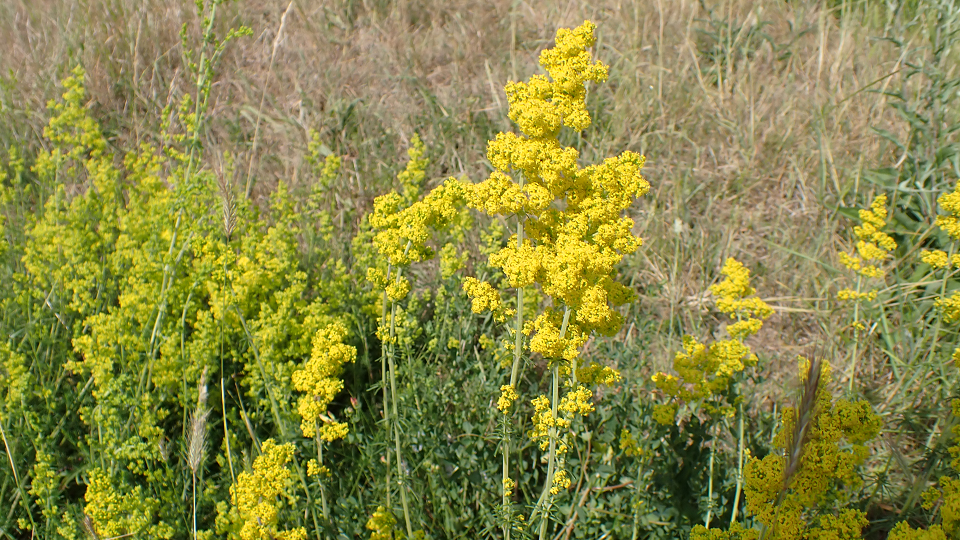
TQ4792 15/05/2025 ©Raymond Small
The angular stems of Lady's bedstraw contain dense clusters of tiny, yellow flowers and narrow leaves that appear in whorls. The plant was once used to fill pillow cases and also to curdle milk when making cheese.
Hedge Bedstraw
Galium mollugo
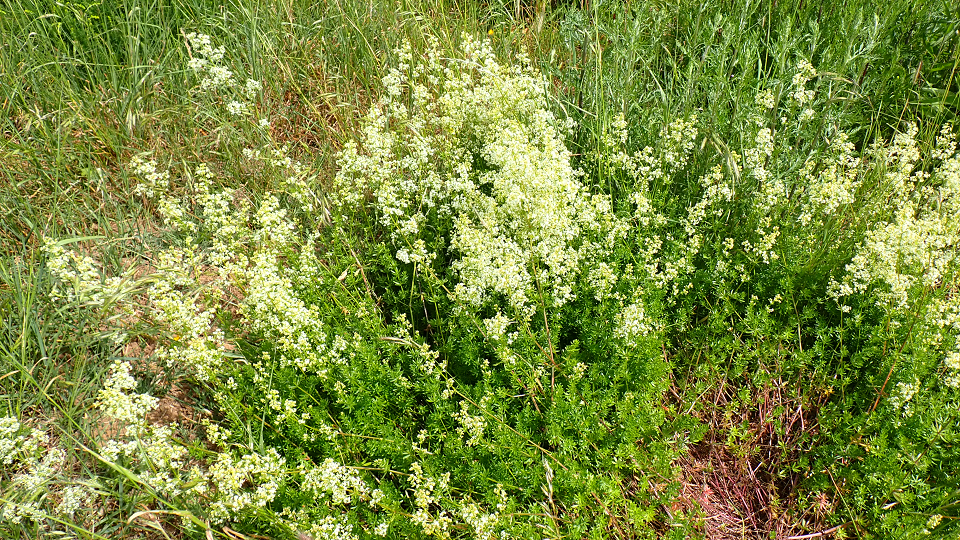
TQ4792 21/06/2025 ©Raymond Small
Hedge Bedstraw has white, four-petaled flowers that appear from late spring. The smooth, hairless, square stem grows erect, but tends to sag when taller due to the weight of the flower clusters. Elliptic leaves grow in circular whorls up the stem.
Goat's-rue
Galega officinalis
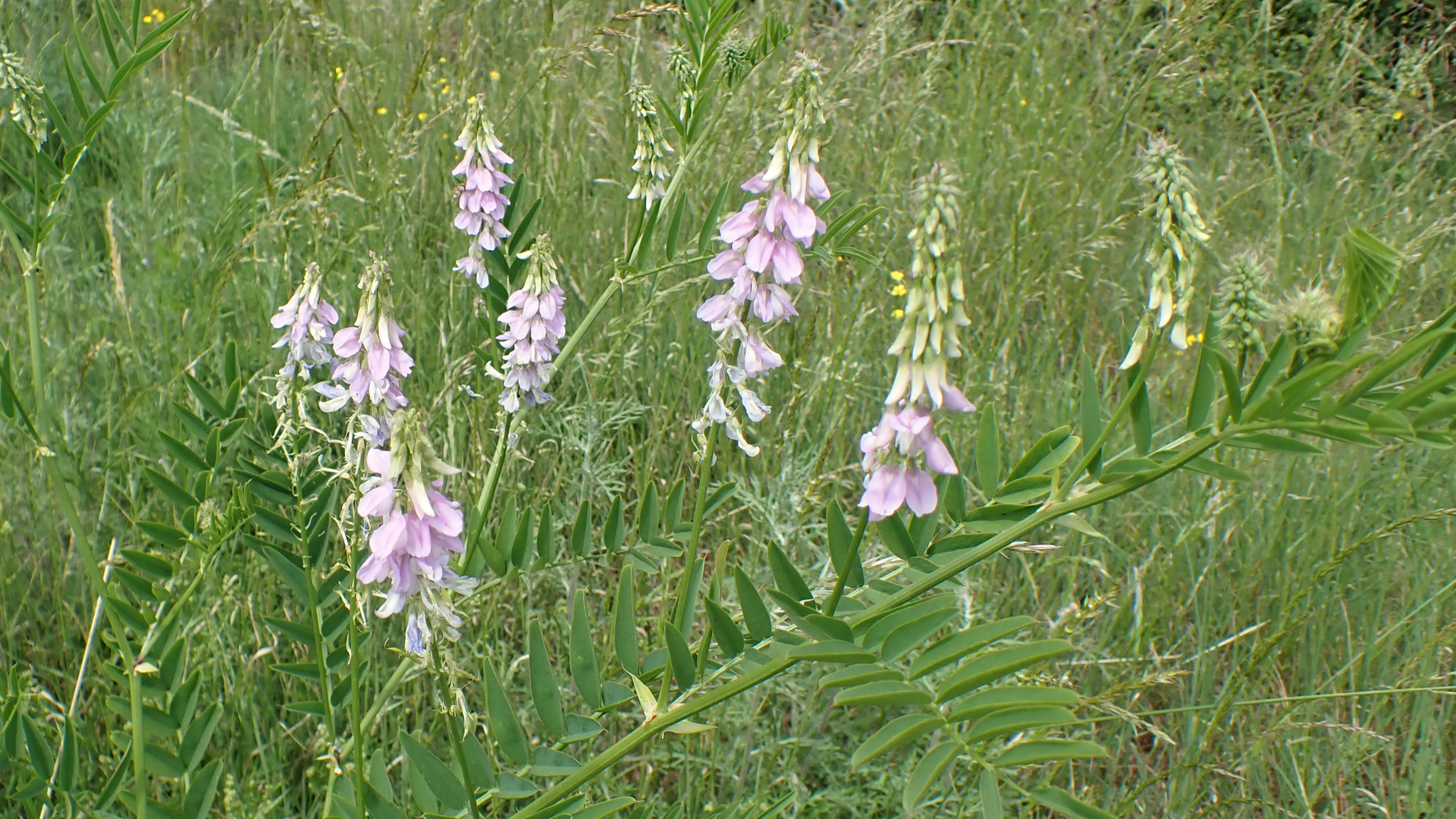
TQ4792 15/06/2025 ©Raymond Small
Goat's-rue is an invasive plant that can be toxic to mammals, but a popular food source for many insects. It is a robust, bushy perennial developing a clump of stems with pinnate leaves, The white, lilac or purple flowers are borne in erect racemes.
Agrimony
Agrimonia eupatoria
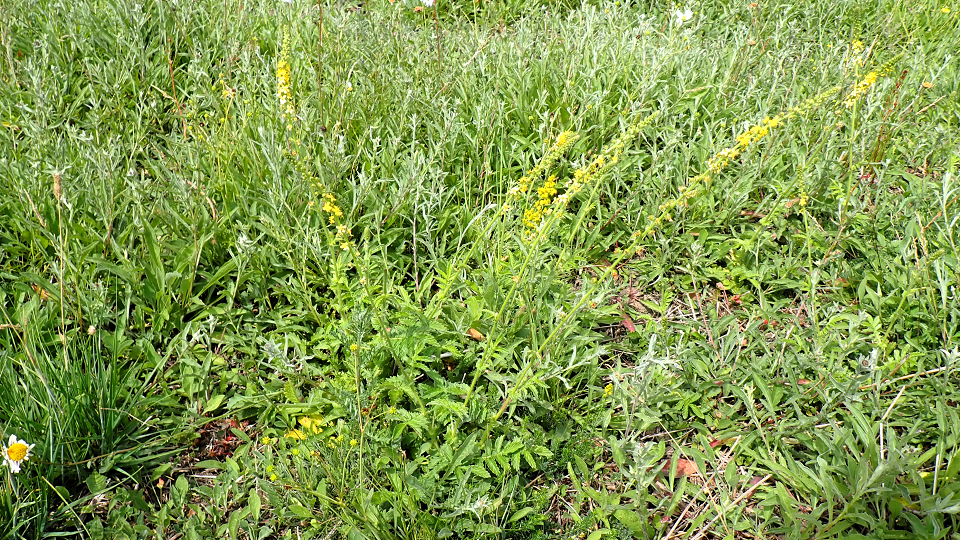
TQ4792 21/06/2025 ©Raymond Small
Agrimony is a perennial that grows up to 60cm tall. The plant is high in tannin and produces a yellow dye that can be used to stain textiles. Also known as 'Lemonade' or 'Bunch-flower'.
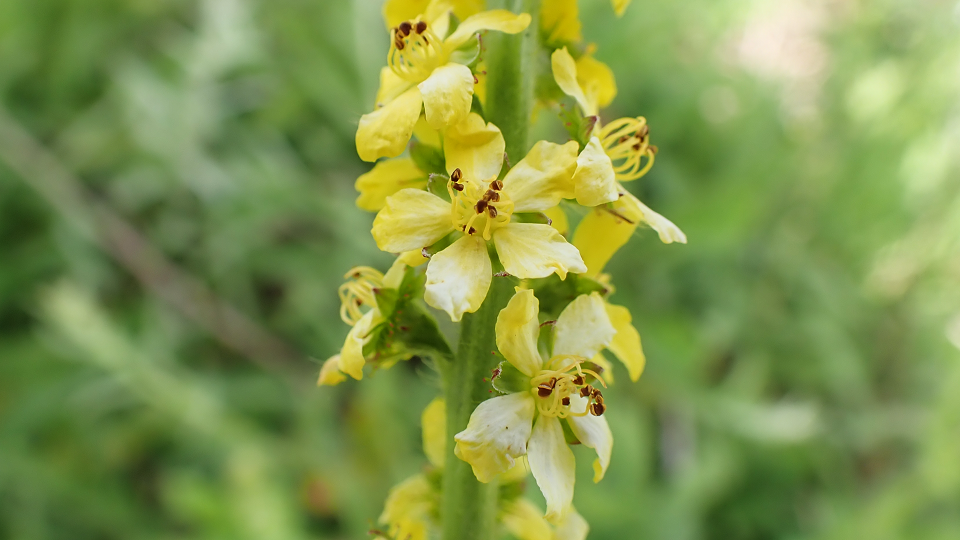
TQ4792 21/06/2025 ©Raymond Small
Yellow star-like flowers bloom in spikes from June to August. The flowers are 5-8mm across and the stem is hairy. Burred seed heads develop afterwards that hook on to animals or humans to disperse the seeds.
Yarrow
Achillea millefolium

TQ4792 15/06/2025 ©Raymond Small
Yarrow can be found in meadows from June to November. It has flat-topped clusters of flower heads and dark green, finely divided, feathery leaves.
Striped Pea Gall
Cynips longiventris
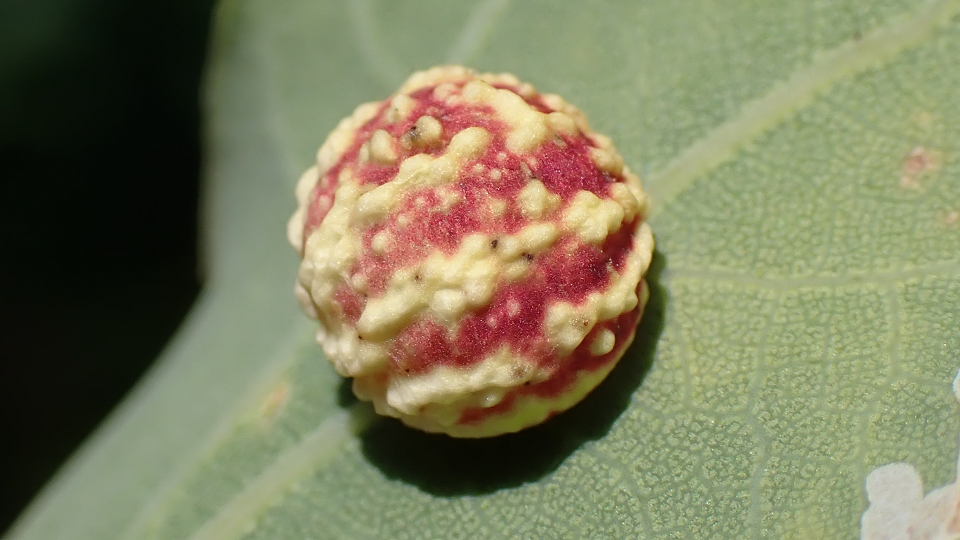
TQ4793 15/06/2025 ©Raymond Small
Striped Pea Galls found on oak leaves are caused by winged agamic female gall wasps. These are now becoming more widespread across Essex.
Loss of a Friend
The website was saddened to hear that Iris Newbery passed away recently. Iris showed great interest in wildlife during her life and was particularly keen on butterflies. She visited Hainault Forest regularly and attended many walks organised by the British Naturalists' Association. She also enjoyed going to Curry Farm, Bradwell-on-sea. a famous retreat for moth and butterfly enthusiasts with its 400 watt purpose built moth trap, Iris will be missed by her many friends and thoughts are with her family at this time of sorrow.
Thank you to everyone that has contributed this month.
The next Journal is expected towards the end of July!
© hainaultforest.net. All rights reserved.
This website uses necessary cookies. It does not use any targeting or advertising cookies.


